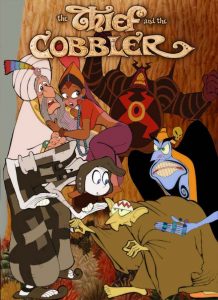 It’s time for a pop culture history lesson. Which came first: Disney’s Aladdin or Warner Brother’s The Thief and the Cobbler? That’s a difficult answer. While Aladdin arrived in theaters in 1992, with Thief in theaters the next year in South Africa and Australia (America in 1995 by Miramax, coincidentally re-named Arabian Knight), Aladdin was stolen straight from the pages of Thief, on which production began in 1964.
It’s time for a pop culture history lesson. Which came first: Disney’s Aladdin or Warner Brother’s The Thief and the Cobbler? That’s a difficult answer. While Aladdin arrived in theaters in 1992, with Thief in theaters the next year in South Africa and Australia (America in 1995 by Miramax, coincidentally re-named Arabian Knight), Aladdin was stolen straight from the pages of Thief, on which production began in 1964.
The Thief and the Cobbler tells the story of three balls. Legend says that if these three balls, at the top of Golden City’s highest minaret, are ever stolen the city would fall to ruin and people will die. The legend states, however, that the “simplest soul with the smallest and simplest of things” can save the city if this happens. So of course, as all prophecies go, the balls are stolen.
When the town’s thief attempts to pickpocket Tack, a local cobbler who is sleeping, Tack unconsciously sews their clothes together, causing the thief to drag him along into the street. This leads both of them in the path of the royal vizier, Zigzag, who accidentally steps on one of Tack’s tacks. The vizier arrests the cobbler (the thief having gotten away) and brings him before the king. When Tack is brought before the king and his daughter, Yum-Yum, she falls in love and saves his life by insisting she needs a cobbler to fix her shoe. While Tack is fixing the princesses shoe, the thief has made his way inside the castle, grabbing everything in sight. One such thing is the ruby on the princess’s scrub brush she is using in the bath (along with the soap). Catching him as he’s running off with the princess’s shoe, both Tack and the thief are captured by Zigzag and locked away in the prison.
 Meanwhile, an army of one-eyed monsters is on its way to take over the kingdom. Of course, the kingdom is safe as long as the balls are still at the top of the minaret – if they still were. It seems they are missing now. To help save the kingdom, the king sends his daughter and Tack to find help, which brings together a band of ruffians to defeat the army. In the end, Tack is the saving grace, the “simplest soul with the smallest of things.”
Meanwhile, an army of one-eyed monsters is on its way to take over the kingdom. Of course, the kingdom is safe as long as the balls are still at the top of the minaret – if they still were. It seems they are missing now. To help save the kingdom, the king sends his daughter and Tack to find help, which brings together a band of ruffians to defeat the army. In the end, Tack is the saving grace, the “simplest soul with the smallest of things.”
There is no Genie or Jinn, no lamp or cave of treasure found by an even more clever thief. No moral about being yourself and not lying to make people like you. Yet the music, characters, and even the backdrop are too close not to see the similarity.
Thief was originally meant to be a silent film, all the characters mute. This was rejected soon after production when producers realized it wouldn’t sell. It was never meant to be a musical though. Music was only added to the story by Warner Brother’s execs when producers and execs realized audience goers were going to more Disney animated musicals. Upon returning to the film after working on Who Framed Roger Rabbit, Richard Williams agreed to a deal with Warner Brothers for the remaining money he needed for the movie provided his team finished on time. The problem is, they didn’t finish on time. On top of that, after spending 31 years on the film, Disney had already released their own version in Aladdin, which had made all the money Warner Brothers had hoped for from their movie. In May 1992, staff went on vacation, returning to emptied desks and a completed film.
With the recent string of live-action remakes of classic Disney animated classics, it’s always important to think back to the classic animated features that may have been. Had The Thief and the Cobbler finished earlier in its 31-year production cycle, the world may have seen a completely different Aladdin.
